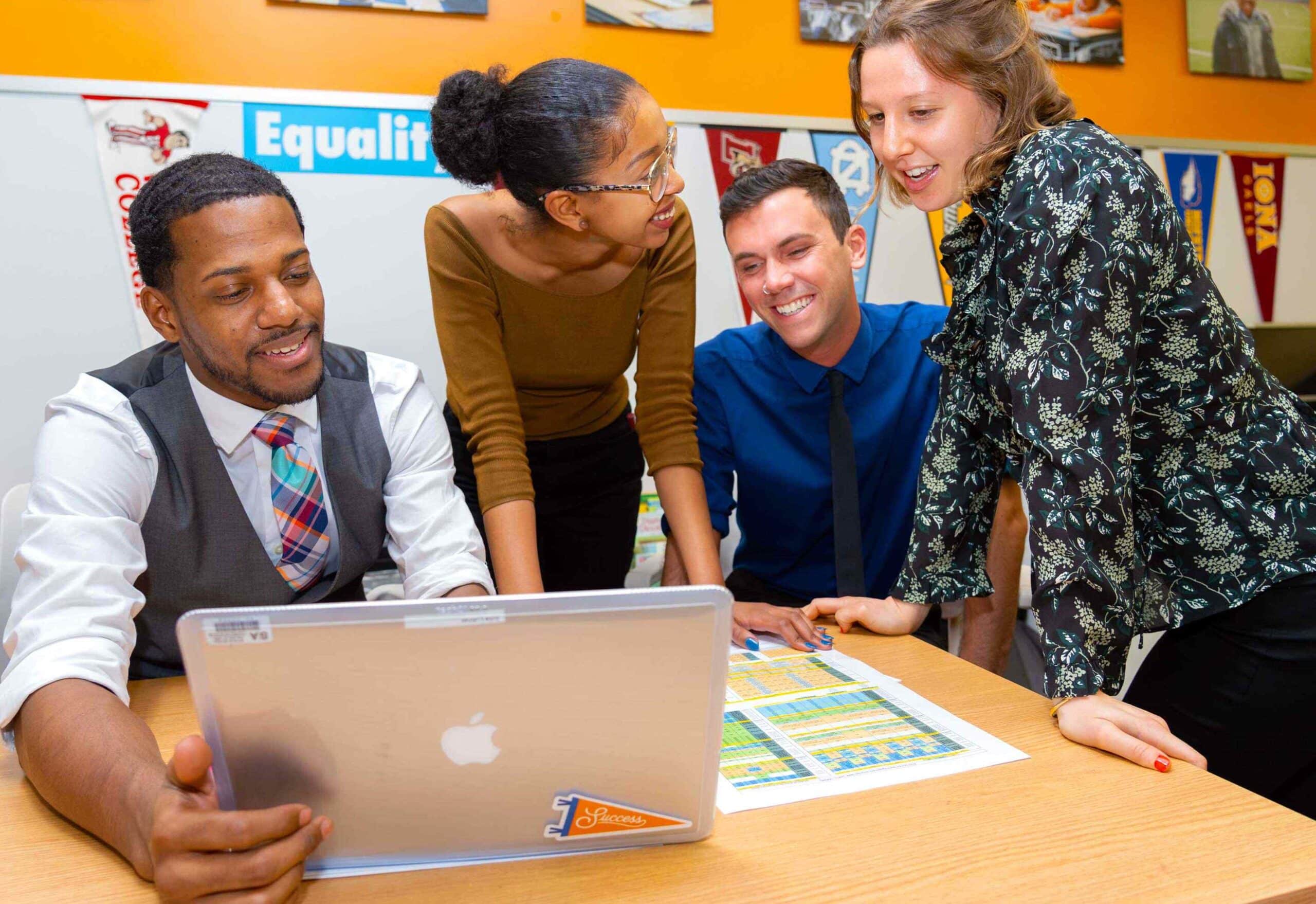


Number Stories is a lesson structure in the Success Academy conceptual math curriculum. It is based on the Cognitively Guided Instruction model. Number Stories teaches students to unpack and solve complex, unfamiliar problems to develop mathematical thinking and problem-solving skills, explain their thinking and construct mathematical arguments, build an understanding of grade-level conjectures and concepts, and apply concepts, strategies, and models learned in math and mini-lessons to novel contexts.
In Grade 4, students encounter a variety of problem types during Number Stories. The Number Stories block happens 2-3 times per week for approximately 40 minutes.
1. Prove it! The idea that scholars will agree or disagree with is, “To multiply a whole number by ten, you can simply put a zero at the end of the original number, and you’ll have the product.”
2. Prove it!” The idea that scholars will agree or disagree with is, “There are zero hundreds in 2032.”
3. Prove it! The idea that scholars will agree or disagree with is, “I would rather have a million pennies than a hundred hundred-dollar bills.”
4. Prove it! The idea that scholars will agree or disagree with is, “The number 1 is both a prime number and a square number.”
5. Prove it! The idea that scholars will agree or disagree with is, “45 + 16 is the same as 40 + 10 plus 5 + 6. So, 45 x 16 is the same as 40 x 10 plus 5 x 6.”
6. Prove it! The idea that scholars will agree or disagree with is, “The perimeter of a square with whole-number side lengths is always a composite number.”
7. Prove it! The idea that scholars will agree or disagree with is, “If we compare two fractions, the one with the smaller denominator is a bigger fraction.”
8. The puzzle that scholars will solve is: “Tom asked his granny how old she was. She told him: “I have 6 children and there are 4 years between each one and the next. I had my first child when I was 19. Now the youngest one is 19 herself. That’s all I’m telling you!” How old is Tom’s granny?”
9. The puzzle that scholars will solve is: “Yolanda is twice as old as Zachary was when Yolanda was Zachary’s age. When Zachary is as old as Yolanda is now, the sum of their ages will be 63. How old are Yolanda and Zachary?”
10. The puzzle that scholars will solve is: “Mrs. Mess went grocery shopping. The bill was seventy dollars. She gave the cashier what she thought were two $50 bills, but accidentally gave him two $100 bills. The cashier was sleepy and didn’t notice, so he gave Mrs. Mess what he thought were three $10 bills, but accidentally gave her three $50 bills. Who ended up better off than they should?”
11. The puzzle that scholars will solve is: “A 5-digit number has the sum of all five digits equal to 5.”
12. The puzzle that scholars will solve is: “A bridge will collapse in 17 minutes. 4 people (A, B, C, and D) want to cross it before it collapses. Only 2 people can cross the bridge at a time. They must cross with a flashlight, but they only have one flashlight among the 4 of them. The fastest each person can cross the bridge is shown in the table below.”
| Person | Time to Cross (min.) |
|---|---|
A |
1 |
B |
2 |
C |
5 |
D |
10 |
How do they all cross before the bridge collapses?
OR
13. The puzzle that scholars will solve is: ” You have a 3-gallon jug and a 5-gallon jug. You need to measure out exactly 7 gallons of water. How can you do it?”
14. The equation that scholars will design a question for is: 3,000 – (4 x 608) = n.
15. The equation that scholars will design a question for is: (5 x 178) + (9 x n) = 989.
16. The equation that scholars will design a question for is: n = ( 20,000 – 14,736 ) ÷ 8
17. Mamadou has a collection of 413 blue marbles and 598 red marbles. How many marbles does he have?
18. The koala is 72 centimeters tall. The zebra is three times as tall as the koala. The elephant is four times as tall as the zebra. How tall is the elephant?
19. Francesca is trying to earn $48 to buy her school uniform this year. The chart below shows how much money Francesca earns per hour doing jobs for her neighbors.
| Job | Money per Hour |
|---|---|
Mowing lawns |
$4 |
Babysitting |
$3 |
Shoveling driveways |
$4 |
Walking dogs |
$2 |
Francesca spent three hours walking dogs last weekend and wants to earn money babysitting next weekend. How many hours will she need to babysit to have enough money to buy her school uniform?
20. Caleb usually eats 1 ¼ waffles for breakfast. At a special brunch one day, Caleb and seven friends share twelve waffles so that each child gets exactly the same amount. At the special brunch, does Caleb eat more or less waffle than usual?
21. The capacities of different ships are shown in the table below.
| Ship Type | Capacity |
|---|---|
Small Ship |
463 |
Cargo Ship |
8,583 |
Cruise Ship |
? |
Battleship ok |
17,402 |
A cruise ship can hold five times as many passengers as a small ship. All ships are required to have one lifeboat for every ten passengers. How many lifeboats does the cruise ship need?
22. The designers of a playground want to build a 36 square foot sandbox. They want the sandbox to be a rectangle with whole number side lengths. What are all the different dimensions the sandbox could have?
23. A soccer team raised $361 in September. The team raised twice as much in October as September. With the money raised in September and October, the team will purchase new soccer balls. Each ball costs $10. How many soccer balls can the team buy?
24. Baldwin High School and Angelou High School each have four grades. Baldwin High School has 978 scholars in each grade. Angelou High School has 1,372 scholars in each grade. How many more scholars attend Angelou High School than Baldwin High School?
25. A dog park is shaped like a regular hexagon. Each side measures 19 feet. Marcus is responsible for putting new fencing around the dog park. Fencing costs $10 per foot. Marcus also needs to pay $10,294 in labor and delivery costs. What is the total cost of fencing the dog park?
26. Sylvia is making a quilt by sewing together squares of fabric. She has 64 squares, and is going to sew them together in an array. What are all the different ways she could arrange the fabric squares?
27. Mr. Carlton had three boxes with 289 prizes in each. During the school day, he visited 15 classrooms and gave out 23 prizes in each classroom. How many prizes does he have left?
28. Challenge Problem: Brandon wants to go on a trip that will cost $3,175. He will use $2,815 from his savings, and will earn the rest of the money by tutoring younger children. He earns $20 per hour for tutoring. How many hours will Brandon need to tutor in order to afford the trip?
29. Challenge Problem: The table below shows the items the hardware store has on its shelves.
| Item | Amount |
|---|---|
Round-head Screws |
1,234 |
Flat-head Screws |
10,089 |
Bolts |
986 |
How many more screws are there than bolts? What is your answer rounded to the nearest ten?
30. Challenge Problem: A zoo is planning to construct a building for a new exhibit. The exhibit will include 586 moths and 1,798 butterflies. One hundred insects can fit in each room. How many rooms should be in the building?
31. Challenge Problem: On Saturday, a baker baked 12 cakes. That was six times as many cakes as he baked on Sunday. The baker used ¾ cup of oil for each cake. How much oil did the baker use over the weekend?
32. Challenge Problem: Lyzzah earned $392 from her summer job. Asher earned four times as much as Lyzzah. Meanwhile, Mamadou worked for 23 hours and earned eighteen dollars per hour. How much more did Asher earn than Mamadou?
33. Challenge Problem: The table below shows the number of school supplies Mr. Gonzalez has.
| Supply | Glue Sticks | Staplers | Pencils | Markers | Pens |
|---|---|---|---|---|---|
Amount |
9,488 |
2,103 |
7,185 |
4,512 |
5,311 |
First, he divides the pencils equally between the five grades in his school. Then, he divides the first grade pencils equally among the three first grade classrooms. How many pencils does each first grade classroom get?
34. Challenge Problem: There were 3,529 people at a play. Of those people, 1,364 were children and the rest were adults. The adults were distributed evenly throughout five different
seating sections. How many adults were seated in each section?
35. Challenge Problem: Hannah bought 3 boxes of strawberries with the same number of strawberries in each box. She and her friends ate 74 strawberries. Now there are 37 strawberries left. How many strawberries were in each box that Hannah bought?
36. Challenge Problem: Briyana is preparing brunch for her cousins and siblings. She baked 4 doughnuts, exactly enough for each of her cousins and siblings to eat half a doughnut. She has 5 cousins. How many siblings does she have?
Click here for a recording sheet template. To print, go to File -> Download as PDF, and print the PDF. To make an editable version, use File -> Make a copy (to make a Google doc).
resources
Access a wide array of articles, webinars, and more, designed to help you help children reach their potential.
NEWSLETTER
"*" indicates required fields



